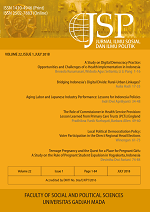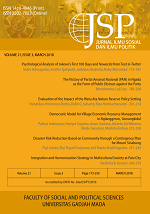Millennials’ Contribution in Disaster Risk Reduction: Case Study of Tidal Flooding in Semarang
Theresia Octastefani(1*), Muhammad Rum(2)
(1) Department of Politics and Government, Faculty of Social and Political Sciences; and Center for Southeast Asian Social Studies, Universitas Gadjah Mada
(2) Department of International Relations, Faculty of Social and Political Sciences; and ASEAN Studies Center, Universitas Gadjah Mada
(*) Corresponding Author
Abstract
This research focuses on the contribution of young millennials in reducing the risk of tidal flooding along the northern coast of Semarang. Young millennials have received special attention in disaster management, and the study of digital transformations in disaster management has become more significant. The objective of this study is to examine how smart disaster responses to natural disasters, specifically the case of tidal flooding in three districts of the city (North Semarang, Genuk, and Tugu) and a district nearby Demak Regency (Sayung). To obtain comprehensive results, this research uses qualitative methods, which data collected through in-depth interviews; Focus Groups Discussion (FGD); observations; and desk studies. This study finds that Millennials’ involvement is very important due to their distance from political interests and innovatively able to offer strategies in reducing the problems caused by tidal floods. The involvement of millennials in disaster management is relevant, given that Semarang will soon enjoy the demographic bonus, i.e. have a significant percentage of its population of productive age. Lastly, this research argues that vibrant public participation in disaster management can only be possible under democratic circumstances. As the implication, the study on public active participation might help disaster risk reduction campaign.
Keywords
Full Text:
PDFReferences
Adger, W. N., Hughes, T. P., Folke, C., Carpenter, S. R., & Rockström, J. (2005). Social-ecological resilience to coastal disasters. Science, 309(5737), 1036-1039. doi: 10.1126/science.1112122
Akeyo, S. O. (2010). Youth involvement in disaster management. Paper presented at The 5th Annual Caribbean Conference on Comprehensive Disaster Management in Jamaica, Montego Bay.
Aldrich, D. P. (2008). The crucial role of civil society in disaster recovery and Japan’s preparedness for emergencies. Japan Aktuell, 3, 81-96.
Andriyanto, W. (2011). Aksi pemuda: Panduan Pengurangan Risiko Bencana berbasis Komunitas (PRBBK) untuk pemuda. Jakarta: Deputi Bidang Pemberdayaan Pemuda, Kementerian Pemuda dan Olahraga, Republik Indonesia.
Badan Nasional Penanggulangan Bencana. (2016). Membangun satu masyarakat ASEAN yang lebih tangguh. Retrieved from https://www.bnpb.go.id/index.php/membangun-satu-asyarakat-asean- yang-lebih-tangguh
Bildan, L. (2003). Disaster management in Southeast Asia: An overview. Bangkok: Asian Disaster Preparedness Center.
Coppola, D. P. (2011). Introduction to international disaster management (2nd ed.). Burlington: Elsevier.
de Albuquerque, J. P., Herfort, B., Brenning, A., & Zipf, A. (2015). A geographic approach for combining social media and authoritative data towards identifying useful information for disaster management. International Journal of Geographical Information Science, 29(4), 667-689. doi: 10.1080/13658816.2014.996567
Drury, A. O., Olson, R. S., & van Belle, D. A. (2005). The politics of humanitarian aid: US foreign disaster assistance 1964-1995. The Journal of Politics, 67(2), 454–473. doi:10.1111/j.1468-2508.2005.00324.x
Fothergill, A. (Ed.). (2017). Children, youth, and disaster. Oxford Research Encyclopedia of Natural Hazard Science. Retrieved from http:/ / naturalhazardscience.oxfordre.com/view/10.1093/ acrefore/9780199389407.001.0001/ acrefore-9780199389407-e-23 doi: 10.1093/ acrefore/9780199389407.013.23
Houston, J. B., Hawthorne, J., Perreault, M. F., Park, E. H., Goldstein, H. M., Halliwell, M. R., …., Griffth, S. A. (2014). Social media and disasters: A functional framework for social media use in disaster planning, response, and research. Disasters, 39(1), 1-22. doi: 10.1111/disa.12092
Lakoff, A .(2010). Disaster and politics of intervention. New York: Columbia University Press.
Mannheim , K. (1952). T he pro blem o f generations. In P. Kecskemeti (Ed.), Essays on the Sociology of Knowledge (pp. 276-320). London: Routledge and Kegan Paul.
Miles, M. B., & Huberman, A. M. (1992). Analisis data kualitatif buku sumber tentang metode-metode baru. Jakarta: Universitas Indonesia Press.
Mitchell, T., Haynes, K., Hall, N., Choong, W., & Oven, K. (2008). The roles of children and youth in communicating disaster risk. Children, Youth and Environments, 18(1), 254-279.
Olasky, M. (2006). The politics of disaster: Katrina, big government, and a new strategy for future crises. Nashville: W Publishing Group.
Patterson, O., Weil, F., & Patel, K. (2010). The role of community in disaster response: Conceptual models. Population Research and Policy Review, 29(2), 127–141. doi:10.1007/s11113-009-9133-x
Pelling, M., & Dill, K. (2010). Disaster politics: Tipping points for change in the adaptation of sociopolitical regimes. Progress in Human Geography, 34(1), 21-37. doi: 10.1177/0309132509105004
Quarantelli, E. L. (1995). Disaster planning, emergency management, and civil protection: The historical development and current characteristics of organized efforts to prevent and respond to disaster. Newark: University of Delaware Disaster Research Center.
Rum, M. (2016). The case of regional disaster management cooperation in ASEAN: A constructivist approach to understanding how international norms travel. Southeast Asian Studies, 5(3), 491-514. doi: 10.20495/ seas.5.3_491
Sawada, Y., & Zen, F. (2014). Disaster management in ASEAN. ERIA Discussion Paper Series, 1-48.
Sen, A. (1999). Development as freedom. New York: Knopf.
Kementerian Pemuda dan Olahraga Republik Indonesia/Kemenpora. (2011). Pelatihan pemuda siaga bencana. Retrieved from http://www.kemenpora.go.id/index/ preview/berita/4082.
Suhelmi, I. R. (2009). Pemanfaatan Multimedia dalam visualisasi model rob berbasis ssistem informasi geografi di Semarang. Jurnal Kebencanaan Indonesia, 2(2), 25-31.
Wahyuni, H.I., Fitrah, A.A., Handayani, F., & Robie, D. (2018). Ecological c o m m u n i c a ti o n i n A s i a - Pa c i f i c : A comparative analysis of social adaptation to maritime disaster in Indonesia and Fiji. Pacific Journalism Review, 24(1), 12-36. doi:10.24135/pjr.v24i1.390
Wulandari, I. (2015, November 23). Kemenporata n ta n g pe m u d a m e nj a d i r e la wa n tanggap benc ana. Republ i k a .c o .i d. Retrieved from http://www.republika. co.id/berita/nasional/umum/15/11/23/ ny9ofu346-kemenpora-tantang-pemuda- menjadi-relawan-tanggap-bencana.
United Nations Office for Disaster Risk Reduction (UNISDR). (2015). Child-friendly Sendai Framework. Retrieved from https://www. unisdr.org/partners/children-youth
Article Metrics
Refbacks
- There are currently no refbacks.
Copyright (c) 2019 Jurnal Ilmu Sosial dan Ilmu Politik

This work is licensed under a Creative Commons Attribution-NonCommercial-NoDerivatives 4.0 International License.






















